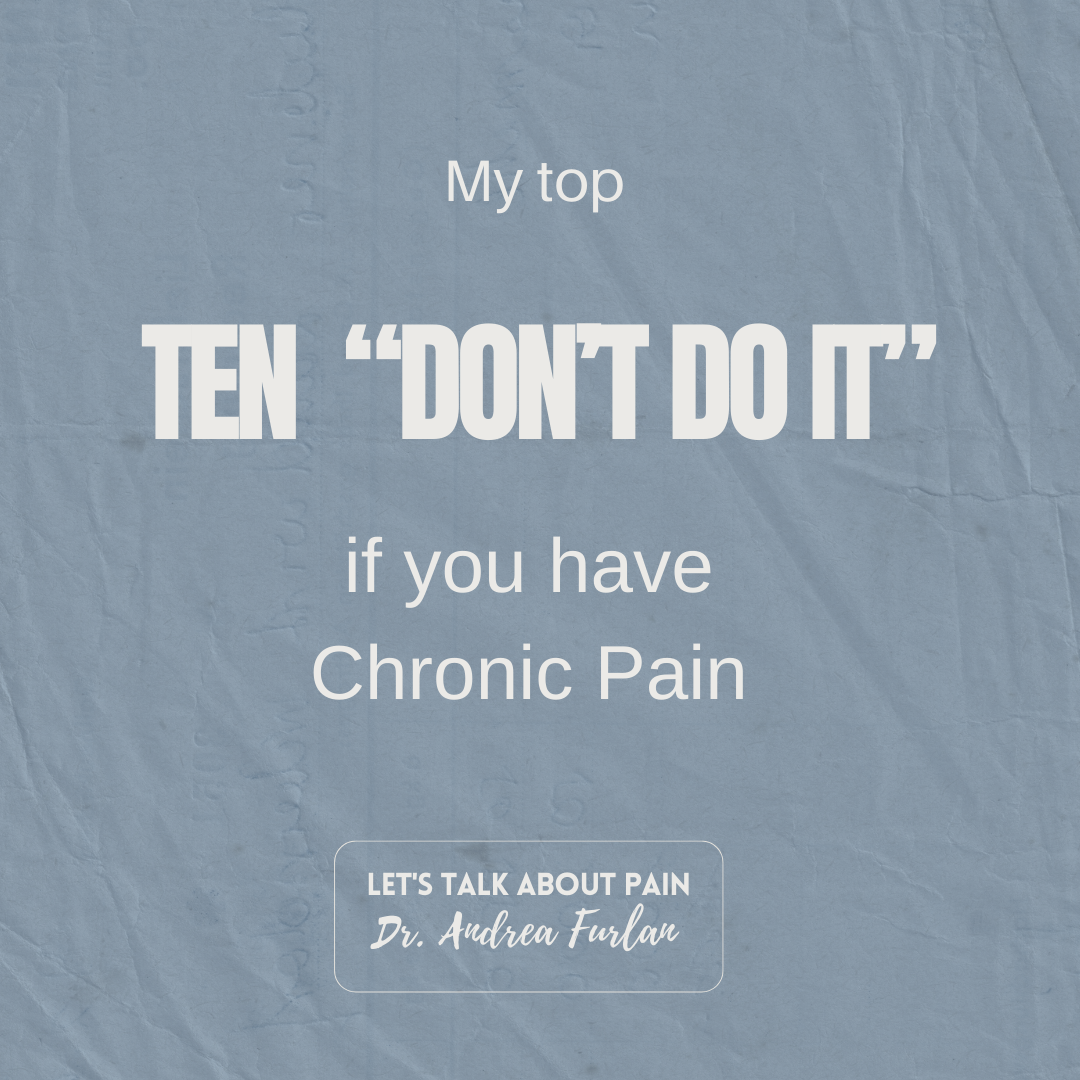My top 10 “Don’t Do It” if you have Chronic Pain
As important as it is to recommend strategies for managing chronic pain, it is equally crucial to recognize the habits and behaviours that can exacerbate discomfort and hinder progress in finding relief.
Living with chronic pain is a daily battle that can significantly impact every aspect of life. Whether it's persistent back pain, migraines, arthritis, or any other form of chronic pain, managing it requires a holistic approach that addresses lifestyle choices, mindset, and coping strategies. Here are my top 10 "don't do it" tips for individuals dealing with chronic pain:
1. Sleep too little or too much
Sleep is essential for managing chronic pain. However, too little or too much sleep can exacerbate pain levels and decrease overall well-being. Aim for a consistent sleep schedule and create a comfortable sleep environment to promote restful sleep. I suggest no less than 7 hours and no more than 9 hours. If taking an afternoon nap, it should not be longer than 30 minutes, and avoid taking naps everyday.
2. Eat processed foods
Processed foods often contain high levels of additives, preservatives, and unhealthy fats, which can contribute to inflammation and worsen chronic pain. Check my video on “Anti-inflammatory Diet” to learn about healthy diet. Opt for a balanced diet rich in fruits, vegetables, lean proteins, and whole grains to support overall health and reduce pain.
3. Sit all day
Prolonged sitting can lead to muscle stiffness, poor conditioning, weak muscles, and increased pain levels, especially for those with chronic pain conditions. Incorporate regular movement breaks throughout the day, and consider using furniture to support proper posture and reduce strain on the body.
4. Drink alcohol
Alcohol can interfere with sleep quality, increase inflammation, and disrupt pain perception, making it a poor choice for individuals managing chronic pain. Limit alcohol consumption and explore alternative ways to relax and unwind, such as meditation or gentle stretching exercises. I have a video about Alcohol and Pain on my my YouTube channel.
5. Smoke
Smoking not only poses serious health risks but can also worsen chronic pain by constricting blood vessels and reducing oxygen flow to tissues. Quitting smoking can improve circulation, decrease inflammation, and potentially alleviate pain symptoms. Check my video about Smoking and Pain.
6. Fear exercises
Exercise is crucial for managing chronic pain as it helps strengthen muscles, improve flexibility, and release endorphins, the body's natural painkillers. Instead of fearing exercise, start with low-impact activities like walking, swimming, or yoga, and gradually increase intensity as tolerated. I have many videos on my YouTube channel about exercises. Check it out!
7. Seek diagnosis solely on imaging tests
While MRI or CT scans can provide valuable information, they rarely pinpoint the exact source of pain in individuals with chronic pain conditions. Relying solely on imaging tests can lead to unnecessary treatments and interventions. Instead, work with your healthcare professionals and consider a comprehensive assessment, including medical history, physical examination, and diagnostic tests, to determine the best action.
8. Rely too much on medications
While medications can provide temporary relief, relying solely on painkillers, especially opioids, can lead to dependence, tolerance, and potential addiction. Opioids can be useful for short-lived acute pain, like nociceptive or neuropathic pain. When the pain becomes nociplastic, they should not be used. Watch my video about “The 3 Types of Pain” on my channel. Explore non-pharmacological pain management strategies such as physical therapy, acupuncture, cognitive-behavioral therapy, and mindfulness techniques to complement medication use and reduce reliance on drugs.
9. Catastrophize
Catastrophizing involves magnifying pain symptoms and anticipating the worst possible outcomes, which can exacerbate distress and decrease pain tolerance. There are psychological interventions to help people who tend to catastrophize. I have many videos about mind-body interventions on my YouTube channel.
10. Isolate from others
Chronic pain can be isolating, but withdrawing from social activities and support networks can worsen emotional well-being and amplify feelings of loneliness and depression. Stay connected with friends, family, and support groups who understand and empathize with your experience, and seek professional help if needed to address mental health concerns.
